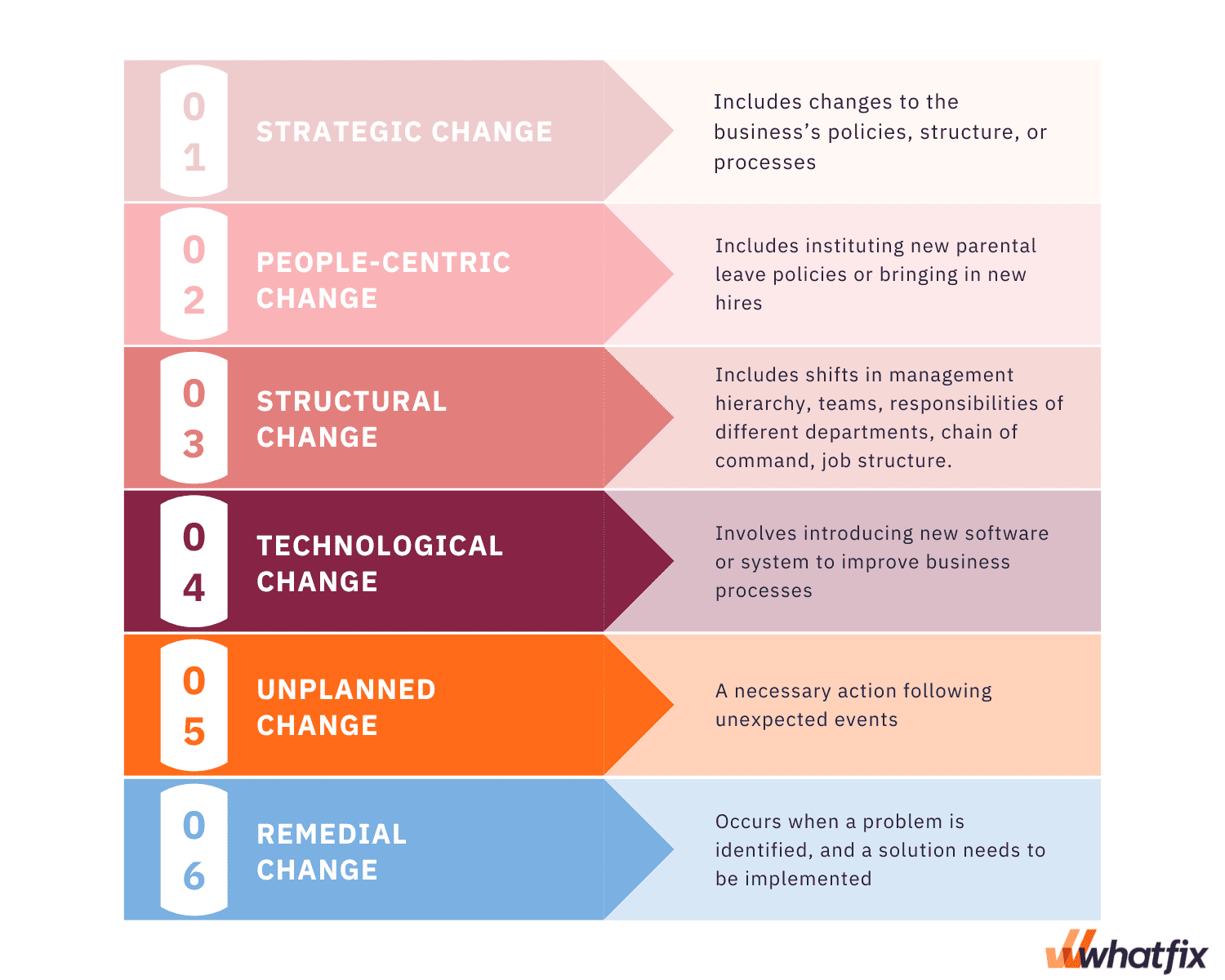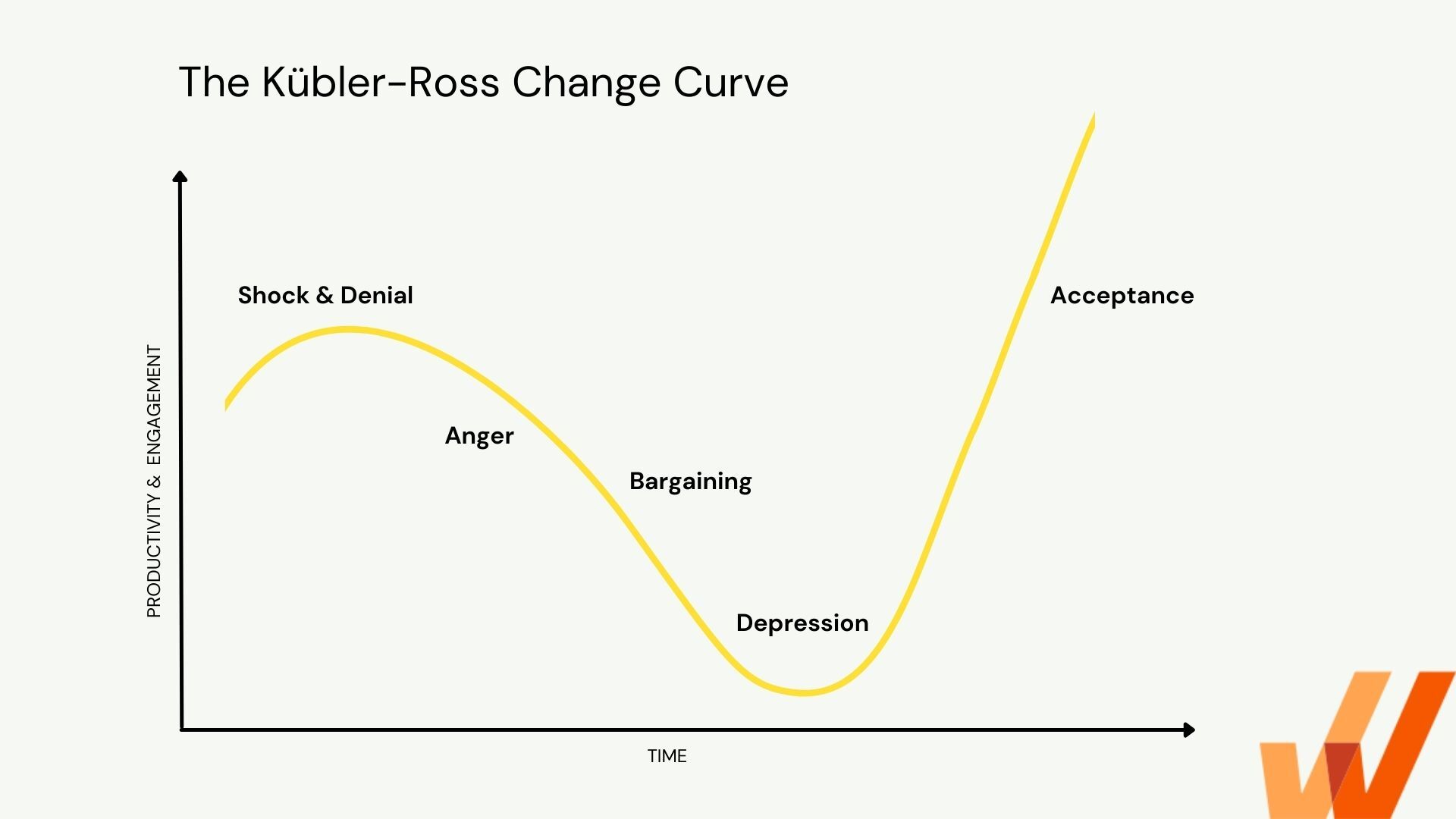

Recognizing the need for change and knowing how to make that change successful are two very different skills. Change management strategy is key—but, where to begin? It all starts with understanding what types of organizational change you’re making.
What Is Organizational Change?
Organizational changes are those that have a significant impact on the organization as a whole. Major shifts to personnel, company goals, service offerings, and operations are all considered different forms of organizational change. It’s a broad category.
Before you can design your change management strategy, it is important to determine the type of organizational change. This helps execute the right change management plan for the best possible results. Knowing the type of organizational change will also help you choose the right change management tools.
Why Is Organizational Change Management Important?
Organizational change is a business necessity. Employees leave, and new employees are hired, new teams and departments are created as the company grows, and businesses adopt new technology to stay ahead of the curve.
The key to successful, productive organizational change is the way you manage it. It’s vital to keep employees in the loop and ensure that they understand what the changes are and how employees will be affected.
With effective organizational change management, you can keep the business running smoothly during the transition. For example, offering effective training helps employees learn new technology faster. That way, they fully adopt the technology, and the organizational change isn’t bogged down by support tickets and frustrated users.
By identifying the types of organizational change you will be implementing, you can make a plan for keeping employees informed. You can ask for change feedback as you implement the change and then make adjustments to your change management plan so that your team has the support they need to maintain high morale and facilitate the change from their end.
✓ Thank you, the template will be sent to your email
Download your copy of FREE change management plan templates for your organizational change initiatives.
6 Types of Organizational Change
Different types of organizational change require different strategies. Everything from implementation to communication must be tailored to the type of change to be made.
Here are the six most common types of organizational change, along with change management examples for each:

1. Strategic change
Organizations implement strategic changes to their business to achieve goals, boost competitive advantage in the market, or respond to market opportunities or threats. A strategic change includes making changes to the business’s policies, structure, or processes. The upper management and the Chief Executive Officer often bear the responsibility for strategic change.
Here are three examples of strategic change in an organization:
- Updating your mission as you grow
When companies first launch, the initial focus is often on lead generation and client aquisition. However, once the company has an established customer base, the focus could shift to upselling. When the main mission changes, the company’s mission also needs to evolve.
- Innovation
Strategic change through digital innovation refers to using skills and resources to develop new ideas or improve existing offerings in order to meet customers’ new and changing demands. Focusing on innovation often requires investing heavily in research and development activities and the latest technology.
- Restructuring
Restructuring leads organizations to reorganizing aspects of their company to survive a massive blow or to maximize their already profitable business. Restructuring can result in downsizing or upsizing the workforce. For example, during COVID-19, the tourism and hospitality sectors were the two of the worst-hit industries in terms of employee lay-offs and losses.
2. People-centric organizational change
While all changes affect people, people-centric types of organizational change include instituting new parental leave policies or bringing in new hires. When implementing a people-centric change, the leadership must bear in mind that employees will naturally resist change.
A people‐centric change requires transparency, communication, effective leadership, and an empathetic approach.
Note:Many change management models, such as the Kübler-Ross Change Curve and Satir Change Model, focus specifically on managing emotional reactions to change.

Here are three examples of strategic change in an organization:
- New hire onboarding
Bringing on new team members requires effective onboarding and training, which affect both the new hires and the established employees. You need to start with communicating the reason for hiring new people to the team.
Are they going to lighten the workload? Will they fill in the skills gaps? How will they integrate with the current team?
Be ready to answer the above questions and have a solid plan to avoid negative reactions. Get ahead of concerns like the extra time it will take to train the new employees on existing tools.
- Changes to roles and responsibilities
Job descriptions can evolve over time. Changes to an employee’s responsibilities may require additional training or upskilling and restructuring of teams. Of course, shaking up routines is a delicate process. It’s essential to have a strategy for change implementation and communication.
People like purposeful change. Communicating the value of the change is essential. If you are adding a responsibility to someone’s role, the employee will be more likely to receive the news well if they understand the reason behind it.
Consider the following options for announcing the new responsibility:
Option A: “Starting next month, the marketing team will be required to use Oracle to create monthly reports on email marketing efforts.”
Option B: “Oracle’s built-in analytics simplify the process of monitoring email marketing efforts and running reports. Harnessing those analytics will allow us to create detailed reports for clients and offer them more value. Starting next month, the marketing team will be in charge of creating and delivering reports to clients. ”
Which option do you think would be better received?
- Layoffs
If your company undergoes mass hiring or layoffs, forcing you to change your internal operations and processes, the situation has to be dealt with by keeping in mind its impact on both the laid-off and the remaining employees’ morale.
Give your laid-off employees enough time to rehabilitate and move out of the company without any financial or emotional turbulence.
On the other hand, the threat of layoffs might evoke fear and anxiety among your remaining staff members, thereby affecting their morale and productivity. Therefore, the leadership needs to be transparent with these employees, communicate the reasons behind such drastic changes, and answer any questions the employees might have regarding the change.
3. Structural change
Structural changes are changes made to the organization’s structure that might stem from internal or external factors and typically affect how the company is run. Structural changes include major shifts in the management hierarchy, team organization, the responsibilities attributed to different departments, the chain of command, job structure, and administrative procedures.
Circumstances that lead to structural change include mergers and acquisitions, job duplication, changes in the market, and process or policy changes. These changes often overlap with people-centric changes as they directly affect most, if not all, employees.
Here are three examples of strategic change in an organization:
- Mergers and acquisitions
Mergers and acquisitions are the most common cause of structural change. For example, let’s say a company X decided to merge with a company Y. As a part of that merger, duplicate departments are eliminated, employees from both companies are reassigned to new positions, some employees are terminated, new policies and procedures are created, and job functions are realigned to fit the new company structure.
Eliminating role redundancies, redefining goals, clearly defining new roles and responsibilities, and training on technology are all important parts of managing change during mergers and acquisitions.
Lewin’s Change Management Model works well for mergers and acquisitions because it focuses on creating a new status quo. It has three steps: unfreeze, change, and refreeze.
After you unfreeze the current processes, you move on to change. This step should be gradual. This is when the strategy is so crucial. Difficult changes, such as eliminating redundancies, require continuous and open communication. Encourage feedback and listen as much as you talk. Once the changes are in place, you “refreeze” or solidify the change as the new status quo.
- The creation of new teams or departments:
Structural change can also apply to smaller adjustments, such as creating a new team. If you notice that a group of employees have a knack for analytics, you might decide to create a separate team dedicated to reporting.
However, the necessary shifting of personnel and duties could create some tension. To streamline the process, justify the change with clear reasoning, explain the benefits, and highlight the positives. It’s not about taking away responsibilities – it’s about playing to each individual’s strengths.
- Changes to the company organizational chart:
Promotions and new roles call for updates to the organizational chart. When moving people around, be sure to celebrate wins, like promotions, and explain adjustments such as merged departments.
Structural changes influence how your company functions as a whole. It’s never an easy transition, but solidifying the change as soon as possible can help you avoid major issues down the line.
4. Technological change
The increasing market competition and constantly evolving technology lead to technological change within organizations. Technology change often involves introducing new software or systems to improve business processes through SaaS change management. However, technology project goals are often improperly defined and poorly communicated, which scares and frustrates your employees and ultimately leads to resistance.
Technology change management is all about identifying new technology and implementing a digital strategy for improved productivity and profitability.
Here are two examples of technological change:
- Digital transformation
Digital transformation is defined as the integration of digital technology across all business domains, resulting in fundamental changes to how a business operates and delivers value to its customers. While technology is the cornerstone of digital transformation, there is a human component of change management that evolves along with your technology. This is why change management must be the center of your digital transformation vision.
Manage change with empathy and help your employees understand how it can improve their work life. Also, it is important to allow your employees appropriate timelines to adapt to not only the new technologies but also the new agile, customer-centric, design-thinking mindset.
Furthermore, organizations must invest in digital technologies to manage change initiatives. Leverage digital adoption platforms like Whatfix to deliver effective employee upskilling and reskilling programs for your employees.
A DAP helps you provide in-app guidance on different enterprise applications through a variety of formats, such as step-by-step walk-throughs, balloon tips, videos, and written guides. It also tracks the progress of your change initiative and gather feedback from your team.
- Introduction of a new technology
Technology is designed to make our lives easier, but learning curves can make technology-related changes tricky to implement. People generally prefer to stick with what they know.
When introducing new technology, you must have a solid transition plan. People want to know why the technology is necessary, what makes it better than previous solutions, and how you will support them during the transition.
For example, if you plan to switch from an outdated CRM to Salesforce, start by justifying the change. Explain that Salesforce will allow the team to manage leads while also engaging with current customers. Be sure to point out key benefits, like keeping marketing, customer relations, and detailed analytics all in one place.
You can build confidence in the change by explaining that the transition will be supported by various change management tools that offer capabilities such as in-app training, weekly check-ins, and an internal chat for handling questions.
5. Unplanned change
Unplanned change is defined as a necessary action following unexpected events. An unplanned change cannot be predicted but can be dealt with by effective change management.
Here are two examples of unplanned change:
- Shift to remote work
Situations such as the unexpected mass shift of employees to remote work due to the outbreak of virus requires efficient organizational change management skills. Draft a well-defined change management strategy that specifies the aim, goal, purpose, and direction you want the change to follow. The strategy defines the features and characteristics of the change, the timeframe, risks, limitations, and potential employee resistance.
Some essential strategies that companies can use to manage remote employees during change include:
- Communicating more frequently and thoroughly to avoid misunderstandings and assumptions.
- Having the tools and processes in place to boost virtual employee engagement.
- Prioritizing learning and development to continuously upskill employees on the latest technology via employee training software.
- Using change managers to help individual employees adapt to the remote culture.
- Providing flexible working schedules for remote employees to maintain a healthy work-life balance.
- Loss of critical personnel
An unplanned change can also take place if another company or a competitor wooes away one of your most valued team members with an exciting promotion, or higher salary. In the event of employee turnover in critical roles, succession planning is the most effective way to minimize the affect of such change.
A succession plan identifies critical positions, future staffing needs, documenting and transferring key knowledge, and the people that could fill these future roles within an organization – and helps develop action plans accordingly.
6. Remedial change
Remedial changes are reactionary. This type of change occurs when a problem is identified, and a solution needs to be implemented. As these changes are designed to address an issue; they call for immediate action.
Reactionary change may not be ideal, but it’s inevitable. The benefit of the remedial change is that judging its success is quick and simple with just one question – was the problem solved or not?
Here are two examples of remedial change:
- Addressing customer communication issues
There is a huge difference between simply handling communication with customers and having an effective communication strategy. If what you’re doing isn’t working, you need to adapt quickly.
Gaming company Activision realized that each time they released a game, customers had a lot of questions and feedback. Agents were prepared for a surge of incoming calls, but Activision realized that their customers preferred to go straight to social media. They had to change their process.
Activision used Salesforce to implement Marketing Cloud’s Social Studio. Marketing Cloud automatically tracks relevant tweets and social media conversations and uploads them to Service Cloud. Now, customers can either be directed to self-service solutions or connected to a live agent.
“It’s an incredible change,” Tim Rondeau, Activision’s Senior Director of Customer Care, told Salesforce. “We’re reducing costs and increasing satisfaction at the same time.”
It’s easy to use stories like this one as a reason for a change, but don’t forget to present answers to WIIFM and WDIMTM. If you were to announce a similar change to your customer service team, you’d want to focus more on how it affects them personally.
In this case, the WIIFM is that employees will spend less time on repetitive questions. The WDIMTM is that they’ll need to be trained on Salesforce Marketing Cloud.
- Providing more training for new hires
Highly inefficient processes often lead to remedial changes. You might notice that new employees are struggling to learn internal tools and software. As a result, they are running to established employees with questions. Time is wasted, and everyone ends up frustrated.
In this case, the remedial change could include a combination of a user onboarding program for application training, a company wiki or knowledge base for basic company knowledge, and an onboarding handbook with knowledge resources that promote self-guided learning.
Remedial changes begin with an issue and end with a solution.
It seems simple, but since these changes are reactionary, they can often involve some trial and error. Quick action means you won’t have as much time to plan or transition. The strategy comes into play through monitoring the change. The remedial change is only successful if the identified problem has been solved.
5 Strategies to Drive Successful Organizational Change
Now that you have identified the type of organizational change, here are a few tips to ensure successful organizational change.
1. Clear vision and goals
It’s essential to understand the reasons for the change, how it will impact the business outcomes, and when it will be considered successful.
Formulating and sharing a comprehensible purpose, vision, and goals helps employees and leaders understand the “why” of the change and is critical for the overall success of a change’s implementation.
2. Prioritization
It’s impossible to change everything at once, so it is critical to prioritize the matters you want to tackle first. For example, implementing three new enterprise applications one after another, not all at once.
3. Secure buy-in from your entire organization
It is essential to include all key stakeholders, from leadership and management to executives, to minimize an organization’s resistance to change. This helps employees feel heard, included, and valued – allowing for any conflicts to be aired early in an implementation project and quickly resolved.
Develop a written communication plan to inform all stakeholders about the change. The plan must address all concerns, including what the new business will look like. The communication must be two-way that provide employees with opportunities to ask questions and share their concerns.
4. Build a change implementation plan
A successful change implementation requires a detailed plan to highlight critical milestones systematically. For an effortless rollout, you must plan all of these aspects – project scope, integrations, resources, communication, time, cost, procurement, and risks. A practical implementation plan accelerates the pace of change implementation by anticipating and overcoming barriers and resistance to change.

5. Focus on training & support
On-demand training and support are vital for reinforcing change. You can implement different change management tools that provide training, create knowledge bases, track progress, etc.
For instance, implement a digital adoption platform to help users effortlessly switch from one tool to another. DAPs enable employee training on any new software or enterprise application via contextual in-app walkthroughs, balloon tips, videos, written guides, and embedded knowledge bases.
Navigating through organizational change is a multi-step process. Whatfix helps you scale enterprise-wide changes, improve user engagement, and drive user adoption. The platform makes it effortless for users to make the change from one tool to another via in-app contextual learning with self-service help modules.
For example, if you are transitioning from a traditional software to Workday as your new human capital management software, you can implement Whatfix DAP to provide in-app guidance for your employees. The digital adoption tool will support the change by helping users onboard to Workday quickly and easily. Plus, with Whatfix’s DAP, you can provide guidance through a variety of formats, such as step-by-step walk-throughs, balloon tips, videos, and written guides.
Intrigued to know more? Schedule a free demo with us today!
Explore more change management content on the Whatfix blog:
Request a demo to see how Whatfix empowers organizations to support change projects by driving user adoption and providing guided walkthroughs.


